<b><font face="Faucets"><strong><u><font
face="georgia, times new roman,times"size="3">>
 Faucets
Faucets
 Each
faucet can be “turned on” more or less, creating a great variety of sonic
events. If the water pressure (in the case of singing, it's air pressure)
is strong, each faucet will have some water coming out of it. This pretty
much is the way singers “work” the air flowing through their vocal tracts
and out into a room, auditorium or a microphone. We will examine each
“faucet” to see how it works, and how it affects singing
technique.<br><br> Remember, it is through the control of the
flow of air through “containers” of varying and changing sizes that a
singer exercises his or her technique(s).Most writings about voice
production begin with a chapter about breathing. Generally speaking, a
singer needs to inhale enough breath to sing the next phrase. The
diaphragm is what sucks the air into the lungs. It is only an organ of
inspiration (breathing in). The minute it stops breathing in, it relaxes.
You do NOT sing with the diaphragm! Your several sets of abdominal muscles
are responsible for your singing, speaking, blowing up balloons, etc. You
breathe in with the diaphragm.We are concerned here with how you use the
air you inhaled into your lungs.Let's take a look at some of the things in
your body which do some of the work when you sing.<br> <img
alt=">
Each
faucet can be “turned on” more or less, creating a great variety of sonic
events. If the water pressure (in the case of singing, it's air pressure)
is strong, each faucet will have some water coming out of it. This pretty
much is the way singers “work” the air flowing through their vocal tracts
and out into a room, auditorium or a microphone. We will examine each
“faucet” to see how it works, and how it affects singing
technique.<br><br> Remember, it is through the control of the
flow of air through “containers” of varying and changing sizes that a
singer exercises his or her technique(s).Most writings about voice
production begin with a chapter about breathing. Generally speaking, a
singer needs to inhale enough breath to sing the next phrase. The
diaphragm is what sucks the air into the lungs. It is only an organ of
inspiration (breathing in). The minute it stops breathing in, it relaxes.
You do NOT sing with the diaphragm! Your several sets of abdominal muscles
are responsible for your singing, speaking, blowing up balloons, etc. You
breathe in with the diaphragm.We are concerned here with how you use the
air you inhaled into your lungs.Let's take a look at some of the things in
your body which do some of the work when you sing.<br> <img
alt=">
When you take a deep breath, you squish your liver and your stomach and
all that soft tissue in a downward direction. Your belly will usually
expand. If you expand your ribcage when inhaling, your stomach won't bulge
out as much. That always looks better. If you notice where the sternum is
above (it's your breastbone) and you elevate that, your ribcage will
expand, your posture will improve, and you will look marvelous. You may
also find yourself getting a better breath when inhaling. Once you have
inhaled, your diaphragm relaxes and your “abs” take on the job of
exhaling, speaking, singing, yelling, etc. If you are speaking, singing or
yelling, your vocal cords go to work as well, providing you with the first
“faucet” with which to squeeze the air being pumped against them from your
lungs. Your abs are the generators of the squeezing of your intestines,
stomach, liver, etc. They get pushed into your relaxed diaphragm, and your
diaphragm gets squeezed up against your lungs.
Faucet #2.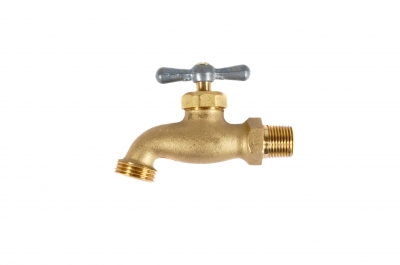
If you have left your vocal cords apart (as when you breathed in) then
that first faucet is entirely open, and creates no resistance to the flow
of air.... you simply exhale. However, if your vocal cords are brought
together and held there, you will be making some sort of sound. This means
the you have adjusted the first faucet, creating some resistance to the
flow of air. Since the vocal cords get pulled together, they begin to
vibrate as the air passes through them. You can make your lips vibrate
almost the same way (they used to call it a “rasberry”). If you add a
resonator by putting your lips in a trombone or tuba mouthpiece, you can
make pitches similar to the way your vocal cords make pitches in your
vocal tract. You can feel the resistance your lips need to make a
“rasberry.” The same is true for the vocal cords. To make pitches, they
vibrate, causing you to feel some resistance in your throat – not a lot
unless your are yelling.
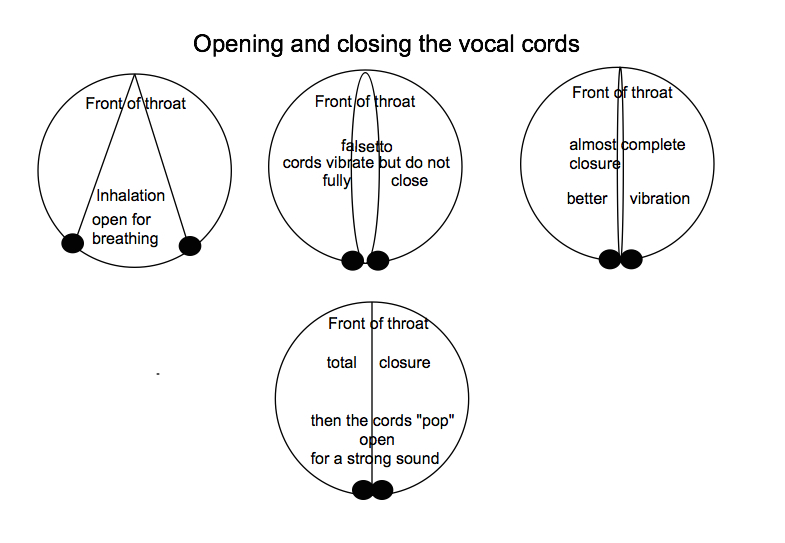


At this point, you might feel some “synergy” between your abs and your
vocal cords – or, you may not. This can prove to be very vexing for some
students as they attempt to understand the concept of what singers call
“support.” More about that in a while.
Faucet #3. 
The next faucet is not used too often by “normal” singers. This faucet
represents the false vocal cords, used by Mongolian singers and Tibetan
monks. These false vocal cords allow one to produce very low sounds in the
voice, as they vibrate along with the vocal cords, but usually an octave
or more below the pitch being sung. It is possible to actually sing two
real pitches at the same time, and even add higher harmonic overtones
above, creating three pitches at the same time. The techniques for using
the false cords can be found on line, but it is better to have a teacher,
as these exercises can be rough on the vocal cords themselves if done to
excess or improperly. These false vocal cords are another pair of “air
squeezers,” adding to the compression of the air flowing in the vocal
tract.

Faucet #4.
Above the false vocal cords is the next faucet – the epiglottis. This
organ can be raised or lowered or turned into a small tube surrounding the
vocal cords (ventriloquists use this trick to “throw” their voices). It is
operated by a group of constrictor muscles that go to work when we
swallow. When lowered over the vocal cords while singing, a “Kermit the
frog” or “Pee Wee Herman” sound is produced. 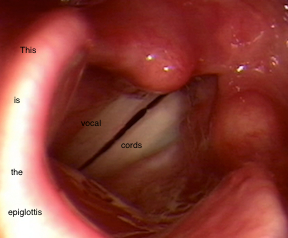

![]()
Faucet #5.
The jaw in singing is most often used as a tuner of both vowels and an
adjuster of vocal “color” or timbre (pronounced tamber – originally a
French word). Choral
directors often direct singers to “drop the jaw” which usually results in
the singers opening the mouth too wide and loosing the very quality the
director was attempting to achieve. The jaw has a sinovial joint –
basically a ball joint in an elliptical holder.
Choral
directors often direct singers to “drop the jaw” which usually results in
the singers opening the mouth too wide and loosing the very quality the
director was attempting to achieve. The jaw has a sinovial joint –
basically a ball joint in an elliptical holder. Generally,
for singing (and the comfort of the singer) the vowel AH in most people
opens the jaw as far as it needs to open for singing – even for high
notes. The “tenor” in the picture is opening more than he needs to! The
wider the mouth is open, the less resonance there is in the mouth cavity.
In this case, the mouth is serving as a sort of megaphone, rather than a
“tuner.” We will explore the tuning concept of each of these “faucets” in
a much more comprehensive manner a bit later. For now we just need to know
that the jaw serves both vowel and timbre.
Generally,
for singing (and the comfort of the singer) the vowel AH in most people
opens the jaw as far as it needs to open for singing – even for high
notes. The “tenor” in the picture is opening more than he needs to! The
wider the mouth is open, the less resonance there is in the mouth cavity.
In this case, the mouth is serving as a sort of megaphone, rather than a
“tuner.” We will explore the tuning concept of each of these “faucets” in
a much more comprehensive manner a bit later. For now we just need to know
that the jaw serves both vowel and timbre.
Faucet
#6.
 This
is the big one! The tongue is probably the most important organ in the
vocal tract – especially for singing. It is often a blessing and a curse
for singer and teacher alike. Sometimes it seems the tongue simply has a
mind of its own and will not do what is asked for. This is often a
teaching problem, as it is very difficult to “train” the tongue to do
things it is not used to doing.There is a way, however, to get that
obstreperous item to do your bidding. It is learning to literally tune the
vocal tract. Not the pitches you are singing, but the vocal tract
itself!Let's examine how the tongue makes two separate cavities in the
vocal tract.
This
is the big one! The tongue is probably the most important organ in the
vocal tract – especially for singing. It is often a blessing and a curse
for singer and teacher alike. Sometimes it seems the tongue simply has a
mind of its own and will not do what is asked for. This is often a
teaching problem, as it is very difficult to “train” the tongue to do
things it is not used to doing.There is a way, however, to get that
obstreperous item to do your bidding. It is learning to literally tune the
vocal tract. Not the pitches you are singing, but the vocal tract
itself!Let's examine how the tongue makes two separate cavities in the
vocal tract.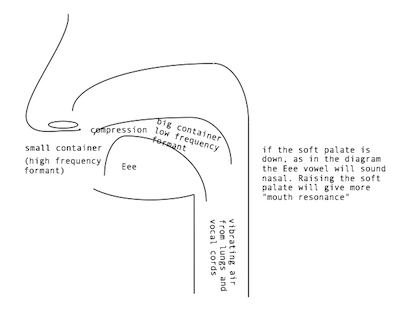 Notice
the
Eee vowel brings the front part of the tongue up and forward, making a
very small cavity in the front of the vocal tract and a large one behind
the “hump” of the tongue. The beginning of the word “human” creates this
tongue position, as does the German word “ich.”The Eh vowel has the hump
in the middle - you can use the “K” in the word “kick” to feel this tongue
position.
Notice
the
Eee vowel brings the front part of the tongue up and forward, making a
very small cavity in the front of the vocal tract and a large one behind
the “hump” of the tongue. The beginning of the word “human” creates this
tongue position, as does the German word “ich.”The Eh vowel has the hump
in the middle - you can use the “K” in the word “kick” to feel this tongue
position.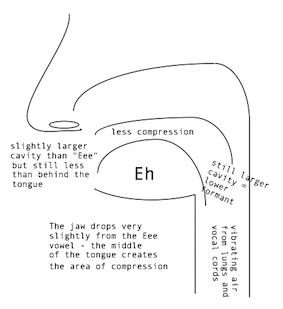 The
Ah vowel position can be found by saying “Bach” and extending the sound of
the “ch.”
The
Ah vowel position can be found by saying “Bach” and extending the sound of
the “ch.”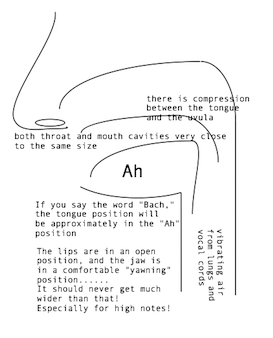 Wherever
the
tongue is near the roof of the mouth it creates some compression. You
might like to think of that as if we had put a short hose with a nozzle on
faucet #6. You can feel the compression on the roof of your mouth for each
of the three vowels: especially on “human” and “Bach.” It's as though you
were aiming a stream of air (from the nozzle effect) at a specific place
on your hard or soft palate. This is the beginning of your understanding
of vocal technique. Not only can you feel that jet of air, but you can
repeatedly do it by yourself again and again without a teacher. You are
learning the concept of “placement.”By moving your tongue into these
repeatable positions, you are training yourself to get a tactile sense of
what the airflow inside the
Wherever
the
tongue is near the roof of the mouth it creates some compression. You
might like to think of that as if we had put a short hose with a nozzle on
faucet #6. You can feel the compression on the roof of your mouth for each
of the three vowels: especially on “human” and “Bach.” It's as though you
were aiming a stream of air (from the nozzle effect) at a specific place
on your hard or soft palate. This is the beginning of your understanding
of vocal technique. Not only can you feel that jet of air, but you can
repeatedly do it by yourself again and again without a teacher. You are
learning the concept of “placement.”By moving your tongue into these
repeatable positions, you are training yourself to get a tactile sense of
what the airflow inside the
vocal
tract feels like to you. This is very important!
This
is the Eee vowel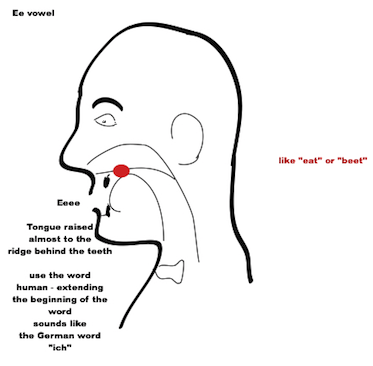
This
is the Eh vowel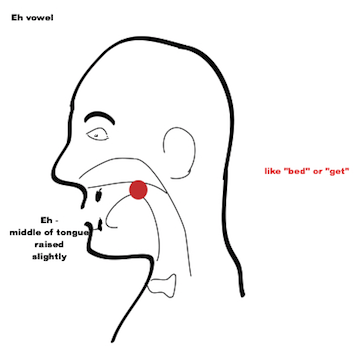
The
picture
on the next page represents the Aaa vowel (as
in
the word bad, hat , sat, etc)
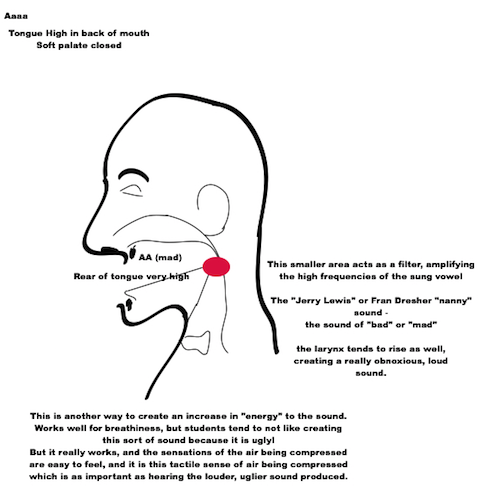 Here
the mouth works more like a megaphone – this is often a “nasty” sound,
generating a lot of high frequencies. Sounds like Jerry Lewis, The Nanny,
or the Aflac duck. A very useful training sound, often found in r and b
singing and in some Eastern European singing styles (Bulgarian Women's
Choirs).
Here
the mouth works more like a megaphone – this is often a “nasty” sound,
generating a lot of high frequencies. Sounds like Jerry Lewis, The Nanny,
or the Aflac duck. A very useful training sound, often found in r and b
singing and in some Eastern European singing styles (Bulgarian Women's
Choirs).
 Faucets
Faucets
 Faucets
Faucets








 Choral
directors often direct singers to “drop the jaw” which usually results in
the singers opening the mouth too wide and loosing the very quality the
director was attempting to achieve. The jaw has a sinovial joint –
basically a ball joint in an elliptical holder.
Choral
directors often direct singers to “drop the jaw” which usually results in
the singers opening the mouth too wide and loosing the very quality the
director was attempting to achieve. The jaw has a sinovial joint –
basically a ball joint in an elliptical holder. Generally,
for singing (and the comfort of the singer) the vowel AH in most people
opens the jaw as far as it needs to open for singing – even for high
notes. The “tenor” in the picture is opening more than he needs to! The
wider the mouth is open, the less resonance there is in the mouth cavity.
In this case, the mouth is serving as a sort of megaphone, rather than a
“tuner.” We will explore the tuning concept of each of these “faucets” in
a much more comprehensive manner a bit later. For now we just need to know
that the jaw serves both vowel and timbre.
Generally,
for singing (and the comfort of the singer) the vowel AH in most people
opens the jaw as far as it needs to open for singing – even for high
notes. The “tenor” in the picture is opening more than he needs to! The
wider the mouth is open, the less resonance there is in the mouth cavity.
In this case, the mouth is serving as a sort of megaphone, rather than a
“tuner.” We will explore the tuning concept of each of these “faucets” in
a much more comprehensive manner a bit later. For now we just need to know
that the jaw serves both vowel and timbre.  This
is the big one! The tongue is probably the most important organ in the
vocal tract – especially for singing. It is often a blessing and a curse
for singer and teacher alike. Sometimes it seems the tongue simply has a
mind of its own and will not do what is asked for. This is often a
teaching problem, as it is very difficult to “train” the tongue to do
things it is not used to doing.There is a way, however, to get that
obstreperous item to do your bidding. It is learning to literally tune the
vocal tract. Not the pitches you are singing, but the vocal tract
itself!Let's examine how the tongue makes two separate cavities in the
vocal tract.
This
is the big one! The tongue is probably the most important organ in the
vocal tract – especially for singing. It is often a blessing and a curse
for singer and teacher alike. Sometimes it seems the tongue simply has a
mind of its own and will not do what is asked for. This is often a
teaching problem, as it is very difficult to “train” the tongue to do
things it is not used to doing.There is a way, however, to get that
obstreperous item to do your bidding. It is learning to literally tune the
vocal tract. Not the pitches you are singing, but the vocal tract
itself!Let's examine how the tongue makes two separate cavities in the
vocal tract. Notice
the
Eee vowel brings the front part of the tongue up and forward, making a
very small cavity in the front of the vocal tract and a large one behind
the “hump” of the tongue. The beginning of the word “human” creates this
tongue position, as does the German word “ich.”The Eh vowel has the hump
in the middle - you can use the “K” in the word “kick” to feel this tongue
position.
Notice
the
Eee vowel brings the front part of the tongue up and forward, making a
very small cavity in the front of the vocal tract and a large one behind
the “hump” of the tongue. The beginning of the word “human” creates this
tongue position, as does the German word “ich.”The Eh vowel has the hump
in the middle - you can use the “K” in the word “kick” to feel this tongue
position. The
Ah vowel position can be found by saying “Bach” and extending the sound of
the “ch.”
The
Ah vowel position can be found by saying “Bach” and extending the sound of
the “ch.” Wherever
the
tongue is near the roof of the mouth it creates some compression. You
might like to think of that as if we had put a short hose with a nozzle on
faucet #6. You can feel the compression on the roof of your mouth for each
of the three vowels: especially on “human” and “Bach.” It's as though you
were aiming a stream of air (from the nozzle effect) at a specific place
on your hard or soft palate. This is the beginning of your understanding
of vocal technique. Not only can you feel that jet of air, but you can
repeatedly do it by yourself again and again without a teacher. You are
learning the concept of “placement.”By moving your tongue into these
repeatable positions, you are training yourself to get a tactile sense of
what the airflow inside the
Wherever
the
tongue is near the roof of the mouth it creates some compression. You
might like to think of that as if we had put a short hose with a nozzle on
faucet #6. You can feel the compression on the roof of your mouth for each
of the three vowels: especially on “human” and “Bach.” It's as though you
were aiming a stream of air (from the nozzle effect) at a specific place
on your hard or soft palate. This is the beginning of your understanding
of vocal technique. Not only can you feel that jet of air, but you can
repeatedly do it by yourself again and again without a teacher. You are
learning the concept of “placement.”By moving your tongue into these
repeatable positions, you are training yourself to get a tactile sense of
what the airflow inside the 

 Here
the mouth works more like a megaphone – this is often a “nasty” sound,
generating a lot of high frequencies. Sounds like Jerry Lewis, The Nanny,
or the Aflac duck. A very useful training sound, often found in r and b
singing and in some Eastern European singing styles (Bulgarian Women's
Choirs).
Here
the mouth works more like a megaphone – this is often a “nasty” sound,
generating a lot of high frequencies. Sounds like Jerry Lewis, The Nanny,
or the Aflac duck. A very useful training sound, often found in r and b
singing and in some Eastern European singing styles (Bulgarian Women's
Choirs).